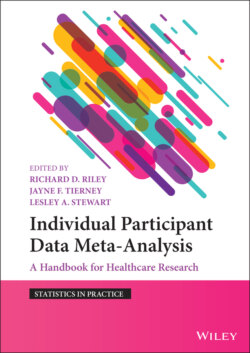Читать книгу Individual Participant Data Meta-Analysis - Группа авторов - Страница 76
4.2.5 Deciding How Much IPD Are Needed
ОглавлениеThe searching and screening process will have produced a set of potentially eligible trials. This may have been refined by seeking early clarifications about trial characteristics, and possibly also by setting an information size threshold (e.g. based on contribution toward power; see Chapter 12), or a quality threshold (e.g. based on an initial risk of bias examination based on published information; see Section 4.2.1), which trials must pass in order to be included. Further clarification and consideration of these issues may be required when more detailed engagement with trial investigators begins, and the likely shape and size of the available IPD emerges.
Figure 4.3 Excerpt from a trial‐level data collection form for the STOPCAP M1 programme of IPD meta‐analyses of therapies for metastatic prostate cancer.94
Source: Based on Tierney JF, Vale CL, Parelukar WR, et al. Evidence Synthesis to Accelerate and Improve the Evaluation of Therapies for Metastatic Hormone-sensitive Prostate Cancer. Eur Urol Focus 2019;5(2):137–43.
Given this set of eligible trials, how much IPD should be sought from them? As a general rule, the aim should be to maximise the quantity and quality of IPD available, in order to fulfil the project objectives and complete the planned analyses reliably. For conventional reviews, aggregate data would ordinarily be sought for all studies relevant to the question of interest. Similarly, and ideally, IPD should be sought from all the eligible trials, for all participants recruited to those trials, and for all relevant outcomes, even if they were not published or included in the original analyses. This will help circumvent the risk of publication bias, outcome reporting bias, attrition bias, and other data availability biases (Chapter 9).46.58,95 For example, in trials of the effectiveness of recombinant human bone morphogenetic protein‐2 for spinal fusion, the adverse event data were not reported sufficiently to allow a rigorous evaluation of safety,96 whereas the collection of IPD allowed a complete, detailed, and in‐depth analysis.65 If it is not feasible or practical to seek IPD from all trials, the potential impact of these ‘missing’ trials should be taken into account (Chapter 9).
